- Best Pandemic Mash-up of Two South Shore Businesses
- Best Coffee Shop to Eradicate Your Misanthropy
- Best Big Collage
- Best Neighborhood Mainstay
- Best Pandemic Public Music
- Best Hard-Won Grocery Store
- Best Movement to End Chicago’s Largest Private Police Force and Best Abolitionist Dance Parties
- Best Homegrown Humanitarian
- Best Socially-Distanced Revels
We moved into our place in the late fall of 2012. We met neighbors in the family buildings on either side of us, three generations deep, in South Shore for decades. And Hasan Park was soon our front yard living room, no matter the miserable temperatures. Ella, five, and Malcolm, six, climbed, slid, and raced with their rambunctious set while we paced and shivered with fellow caregivers. We’d become acquainted with more folks at community organizing meetings, brought together by multiple crises. O’Keeffe was our nearest elementary school, and its entire staff had been fired and replaced. Fermi Elementary, about a mile to the west, was one of fifty neighborhood schools slated for permanent closure. Our local Dominick’s would also be shuttering, leaving the closest full-service grocery two miles away.
Soon I’d meet Sylvia. A mom and grandmother and former eighteen-wheeler trucker, she made a living as a registered CNA and a part-time caterer. This work was balanced with organizing and creating events for nourishment and fellowship in her neighborhood of Park Side, an area of South Shore where many people displaced by the demolition of high-rise public housing relocated. Sylvia organized Peace Fests, gospel concerts, and movie screenings in abandoned lots; she cooked an annual Christmas buffet that was accompanied by a gift giveaway. She also prepared enormous feasts in the warm months, making the occasion for what she calls Community Feeds. Sylvia’s grandparents had migrated to Chicago as young adults. Her mother’s people came from Louisiana. Her father’s people came from Tennessee and Mississippi. As a girl, Sylvia lived in Wentworth Gardens, then and now public housing. And this is where she first learned about community gardens. Southern folks came up with this know-how, she told me, and at Wentworth Gardens, their gardens once thrived.
Sometimes we’d head out after dinner, just the three of us, scaling the wall bordering the sidewalk at Sixty-Seventh and the public golf course. Atop that wall, we’d inch towards wild mulberry, with Maurice holding Ella steady and high. As she grabbed and tasted the sweetness, I made peace with rose-purpley stains, the only price for what my husband called goodney. From there, we’d pass across the tended lawn, saluting the golfers we’d startle, and then it was on to the tangle of bramble, on to the edge of Lake Michigan. Ella was strong and confident enough to take her own stony path safely down to the water. Back then, we called the place Turkey Burger Beach. The slabs of red-brown slags were our roomy perches before the lake. Quiet beach. Unofficial beach. Free of flags and unattended by lifeguards. The north skyline Oz-like. To the south: the smokestacks of Gary Steelworks. Straight ahead: lake and sky melded. That first summer the beach was magnetic. Can you believe it? Nearby and magnificent, still grieving the death of my mother, the lake was my tonic. Choppy or still. Arm’s length away. Numbingly cold and piercing and wondrous.
We’d measure our time in South Shore by the hidden beach’s changes. The second summer would be the summer of thick dragonflies hovering. There’d be the summer of the coyote dashing away from the brush. And, of course, the near constant occasions: those many weeks of high E. coli count and keeping bacteria test strips in my shoulder bag. We’d meet regulars. A trio of middle-aged Polish women from the Southwest Side, always sunning and swimming for entire Saturdays with a transistor radio, folding chairs, and small overflowing picnic basket in tow. At dusk on weekdays: a young man in a white Thobe and turban, praying on a limestone ledge.
When a visiting friend from Atlanta made the stroll to the beach with us, he’d ask how we could afford all of this beauty. My husband and I would try to explain Chicago-style white flight and the Black Belt, and how Chicago segregation persists—how we’d come to know and feel the city’s ironclad segregation. If a Chicago neighborhood was black enough, it would stay black, we’d attest. This seemed as certain to us as the lake being east. What we didn’t acknowledge was Black Chicago was rapidly shrinking. Maurice and I were children of the second wave of the Great Migration. Ella and Malcolm arrived in the time of the Great Exodus. (Audrey Petty)
Excerpted from “Between the Lake and Emmett Till Road,” first published in The Chicago Neighborhood Guidebook (Belt Publishing, 2019).
Best Pandemic Mash-up of Two South Shore Businesses
The Quarry & Soul Vegetarian Restaurant
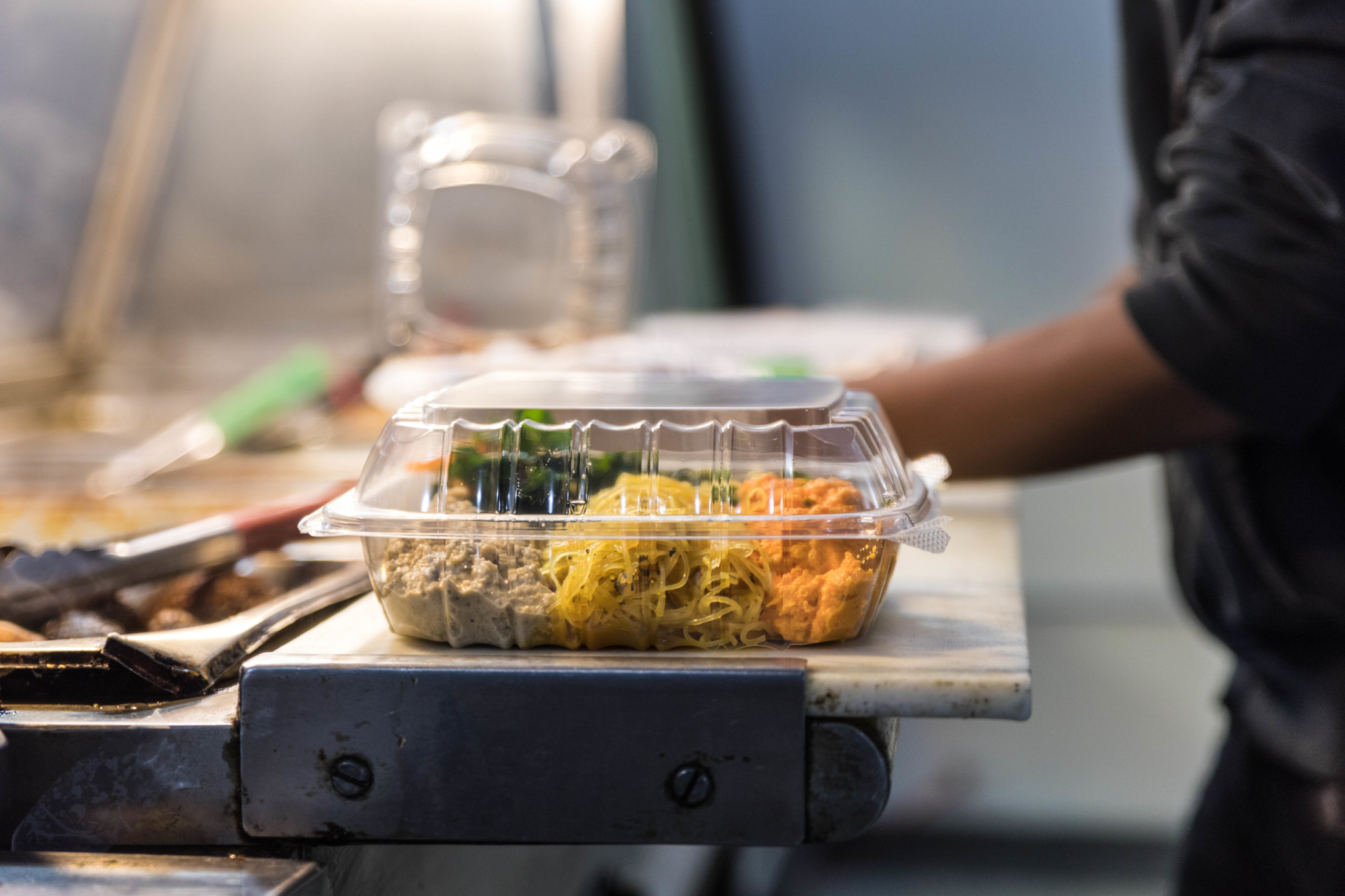
As with so many spaces designed for public programming, The Quarry (Best Deep Dig, 2015 BoSS) has had to compromise under COVID-19. Since being purchased in 2018 by a social enterprise group created by Real Men Charities, the events space has hosted Black men’s yoga classes, a men’s wellness circle, a free breakfast program for neighborhood families, and a range of arts and cultural programming. But that’s all currently on ice (though breakfasts are still being offered for pickup at Ada S. McKinley Community Services’ Ersula Howard Center and Chicago Youth Centers’ Rebecca K. Crown Center). However, when a door closes, a window still does sometimes open. When nearby Original Soul Vegetarian (Best Meatless Comfort Food, 2017 BoSS) decided to shut down for a few months for renovations, the shared kitchen space at The Quarry proved the perfect spot for a pop-up. Now open six days a week for pickup orders, Soul Veg is doing steady business and plans to work out of the space through the New Year. Once the pandemic is under control, Real Men Charities director Ayinde Cartman told the Weekly he’s eager to restart the wellness programming and “just looking forward to making the space available to young people again.” (Martha Bayne)
Original Soul Vegetarian at The Quarry, 2423 E. 75th St. Available for pickup Monday–Saturday, 11am–6pm; closed Sunday. (773) 224-0104. originalsoulvegetarian.com, thequarrychi.com
Best Coffee Shop to Eradicate Your Misanthropy
Build Coffee
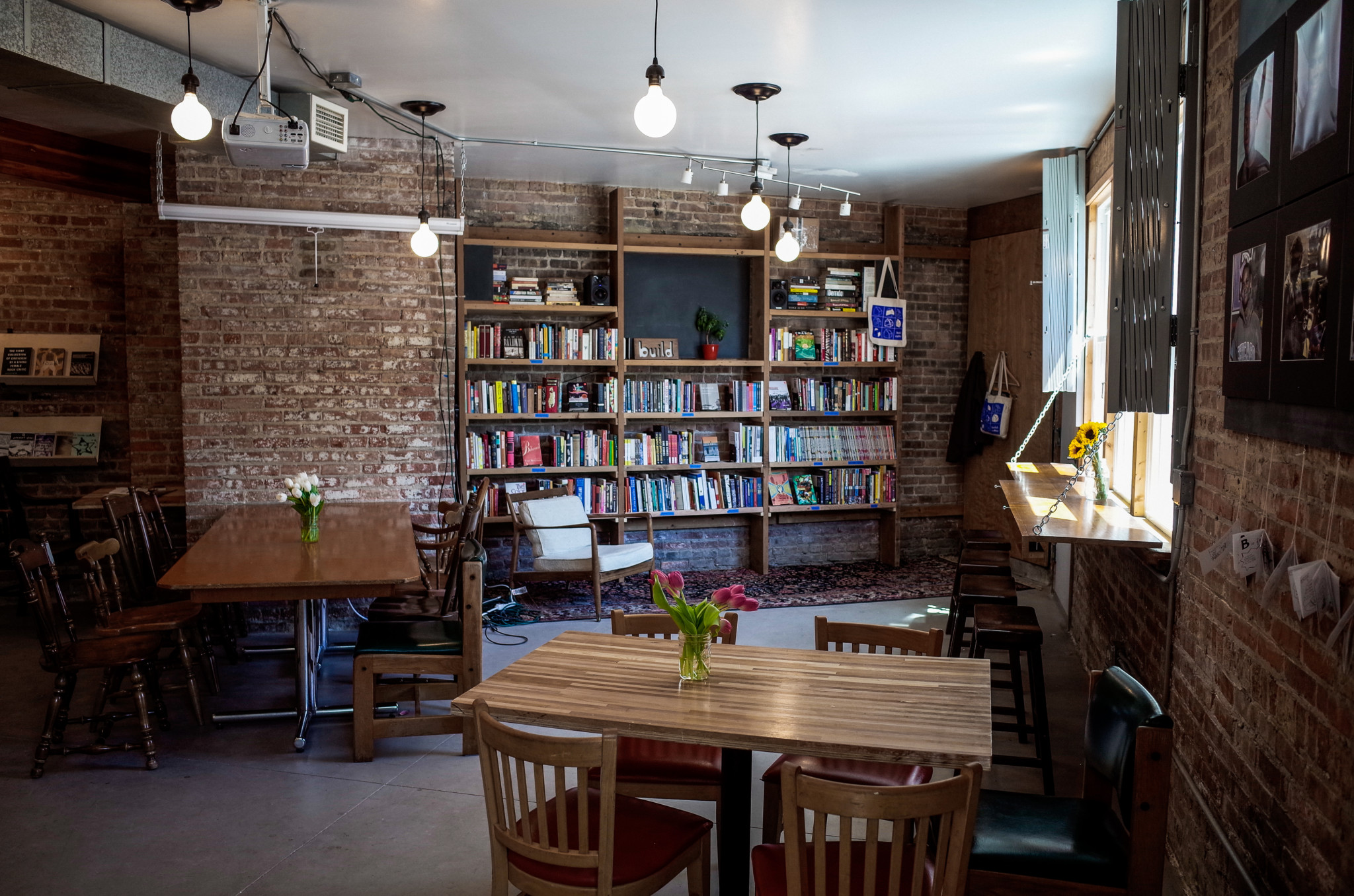
Build Coffee is downright utopian. Tucked into the Experimental Station building at 61st and Blackstone, it is equal parts bustling community hub, spectacular book/zine supplier, and phenomenal cafe. I could rave at length about the incredible drinks—sipping a cardamom rose latte with oat milk is akin to seeing the face of God—but, to be quite honest, I would come here even if the coffee were garbage. Build—founded and run by former Weekly editors Bea Malsky and Hannah Nyhart—is, simply put, a beacon of joy and support for its friends and neighbors. From Public Newsroom events centering civic journalism to patio pop-up shops featuring local artisans and orgs, Build is always finding clever ways to connect and uplift its community. Why merely hang pictures on the walls when you could start a meal-based residency program aiming to nourish and sustain local art and artists?
While the cozy interior is a sight for sore eyes, and spending time there gabbing with the raddest regulars and baristas certainly enhances its charm, Build has still managed to thrive and impact its community in these last few months, even if you can’t currently step inside. Since COVID-19 hit, Build has pivoted to using a walk-up window to keep the crew and customers safe, joined Bookshop.org so that folks could support them virtually (while giving the finger to Jeff Bezos), and partnered with “The People’s Bookshelf” and regular customers to send books to kids across the South Side. As if that weren’t enough, Build—with collaborators at the Experimental Station, including 61st Farmers Market, the Weekly, and the Invisible Institute—launched Market Box, a mutual aid effort that delivered local produce, eggs, and bread to over 800 households over the course of the growing season.
A treasured spot for performances, workshops, book groups, and game nights! A queer dreamscape! A squishy couch to laugh and cry on! A perfect bathroom mirror to selfie in! Build Coffee is the gem of all gems, and I am eternally grateful for the remarkable drinks, books, and humans it has brought to my life. (Wendy Zeldin)
Build Coffee, 6100 S. Blackstone Ave. Walk-up window open Wednesday through Friday 8-3, Saturday and Sunday 9-2, though it is currently closed for winter until further notice. buildcoffee.org. Buy books through Build Coffee at bookshop.org/shop/buildcoffee, where you can also find a reading list from the Weekly. For more information on the Market Box, go to experimentalstation.org/market-box. The Weekly, like Build Coffee, is a tenant of the Experimental Station. Wendy Zeldin is the market manager for the 61st Street Farmers Market, operated by the Experimental Station.
Best Big Collage
Mural Moves Paint Crews at the Former ShoreBank
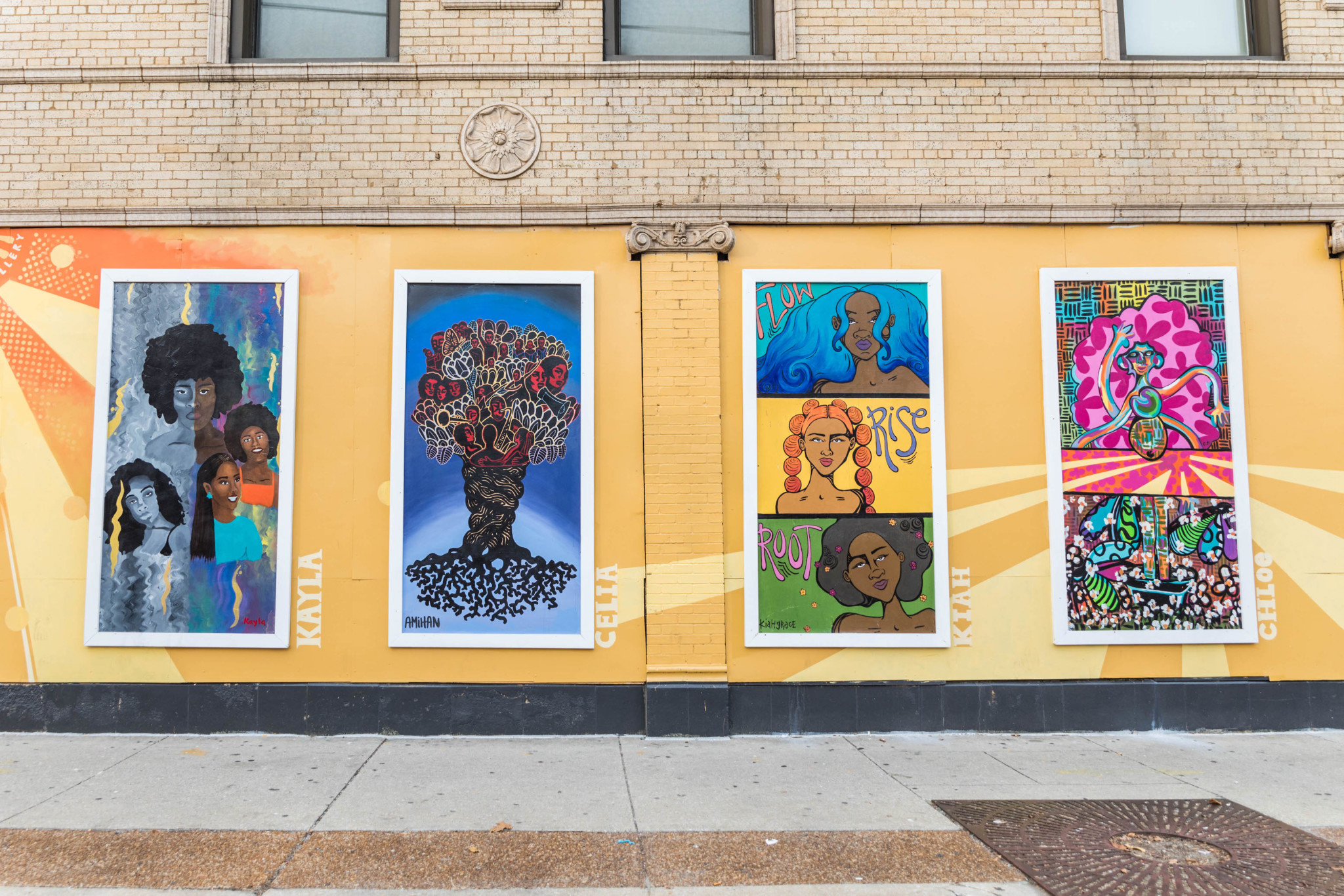
For artist Dorian Sylvain and others, the ShoreBank at 71st and Jeffery was once the center of the South Shore community.
Now, almost ten years after the bank closed for good, that center has been turned inside-out: the exterior wall on East 71st Street is plastered with images of bicyclists and barbecues, horseback riders and hula hoopers, living rooms and loved ones. It’s a family photo album for an entire neighborhood—a bouquet of photos torn from scrapbooks and blown up to scale.
The collage, titled “Better Together,” is one of many recent works by Mural Moves Paint Crews, the organization Sylvain formed to provide a platform for young South Side artists. Accessible art programs have been in short supply on the South Side, and the pandemic has made after-school programs even harder to come by. But miraculously, Mural Moves has gained momentum during the pandemic, with young “fellows” painting 4’ x 8’ panels in Sylvain’s backyard in Kenwood and assembling works like these around the city.
Over the summer, Mural Moves painted the wall on 71st canary-yellow and hung up their artwork, transforming the sidewalk into a sort of open art museum. Dubbed the “Sunlight Gallery,” it is, Sylvain says, in part an ode to the people who—for any number of reasons—don’t get to the interior of an art museum. In October, the “Better Together” collage took shape on the same wall.
Sylvain was raised in South Shore, and her family lived in the area for five decades. She recalls ShoreBank as the “heart of the community, in a lot of ways”—in the days before internet banking and ATMs, you ran into neighbors in line and knew tellers on a first-name basis. The building was originally constructed as the Jeffery Theater, one of the many neoclassical cinemas built on the South Side in the 1920s and 1930s. In the seventies and eighties, under Milton Davis, the bank gained a reputation for making loans accessible for Black homeowners. But the bank spent years in decline, and never recovered from the 2008 recession, closing a few years later.
This latest work is actually Sylvain’s third “public activation” at ShoreBank. In 2017, she painted a mural on walls that were slated to be demolished. But three years later, the building is still standing, and still in a state of disrepair. For Sylvain, the decay called for an answer—so as an act of hope, she painted a wall pink.
Many of Mural Moves’ recent works across the city have been painted on boarded-up shop windows—recession-era signs of the times. The ShoreBank location raises similarly complicated questions about beauty and blight.
But South Shore has deep roots and a history of community action. For Sylvain, the act of reclaiming the bank recalls her first political experience, the fight to save the South Shore Country Club (now the South Shore Cultural Center). “I think even in this moment, claiming the bank, you know, is empowering, Saying ‘this is ours, and this is important. And this is valuable. Yes, it’s kind of raggedy right now, but we’re going to do better soon.’ ”
And for Sylvain, recently named the city’s Auburn Gresham artist-in-residence in a new public art program, community-building isn’t just about the artwork, but about being on the corner day after day, getting to know the strangers who walk by. “People are so kind—and so hungry for art, you know, even if they don’t know it. We don’t know what we need. But when you see it, you’re like, yeah, that feels good.” (Christopher Good)
“Sunlight Gallery” and “Better Together” collage at ShoreBank, 7054 S. Jeffery Blvd.
Best Neighborhood Mainstay
Chef Sara’s Cafe
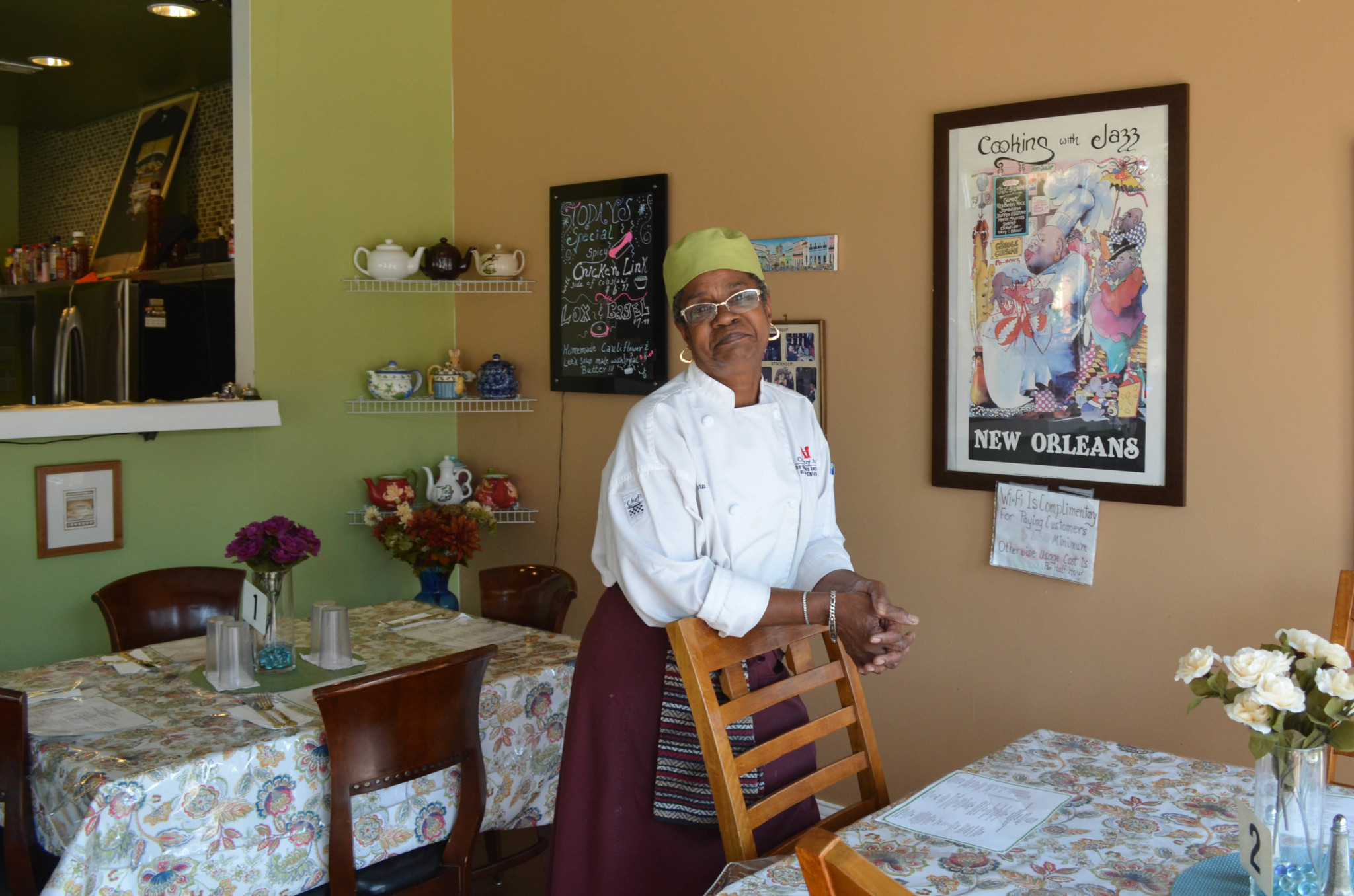
“Nine years,” Sara Phillips tells me. That is how long her cafe, Chef Sara’s (a BoSS regular: Best Corner Hangout in 2012, Best Feedback-Driven Dining Experience in 2015, and Best “Café” in 2017), has been providing perfectly seasoned comfort foods like collard greens, salmon burgers. and, lately, more vegan offerings. Originally from Pittsburgh, Phillips, a former flight attendant, found a welcoming community in South Shore. “South Shore is close to downtown, close to the lake, it is so convenient,” she said. “The bikers, they ride along the lake, and when they get here, they Google where to get coffee.…Once they come in one time, they come back. They used to always say South Shore is like a diamond in the rough, you don’t really know what you got.”
As across the city, the pandemic has been hard on business. Luckily, Chef Sara’s does brisk takeout business, and her warm vibes and enveloping charm still draw a steady stream of regulars and newcomers who have belatedly noticed her cafe nestled at the corner of 72nd and Exchange, across from the South Shore station of the Metra Electric Line.
Even as restaurants shut down to indoor dining again in the face of surging rates of COVID-19 infection, Phillips believes she has weathered the worst of this storm already and looks forward to welcoming diners again someday. “I grew up in my grandmother’s kitchen, and I wanted to make it like my grandmother’s kitchen,” she said. It is almost like Cheers, everybody knows your name. (James Garrison)
Chef Sara’s Cafe, 7201 S. Exchange Ave. Tuesday–Friday, 10am–4pm; Saturday, 10am–3pm; closed Sunday and Monday. (773) 359-4637. chefsarascafe.com
Best Pandemic Public Music
Back Alley Jazz
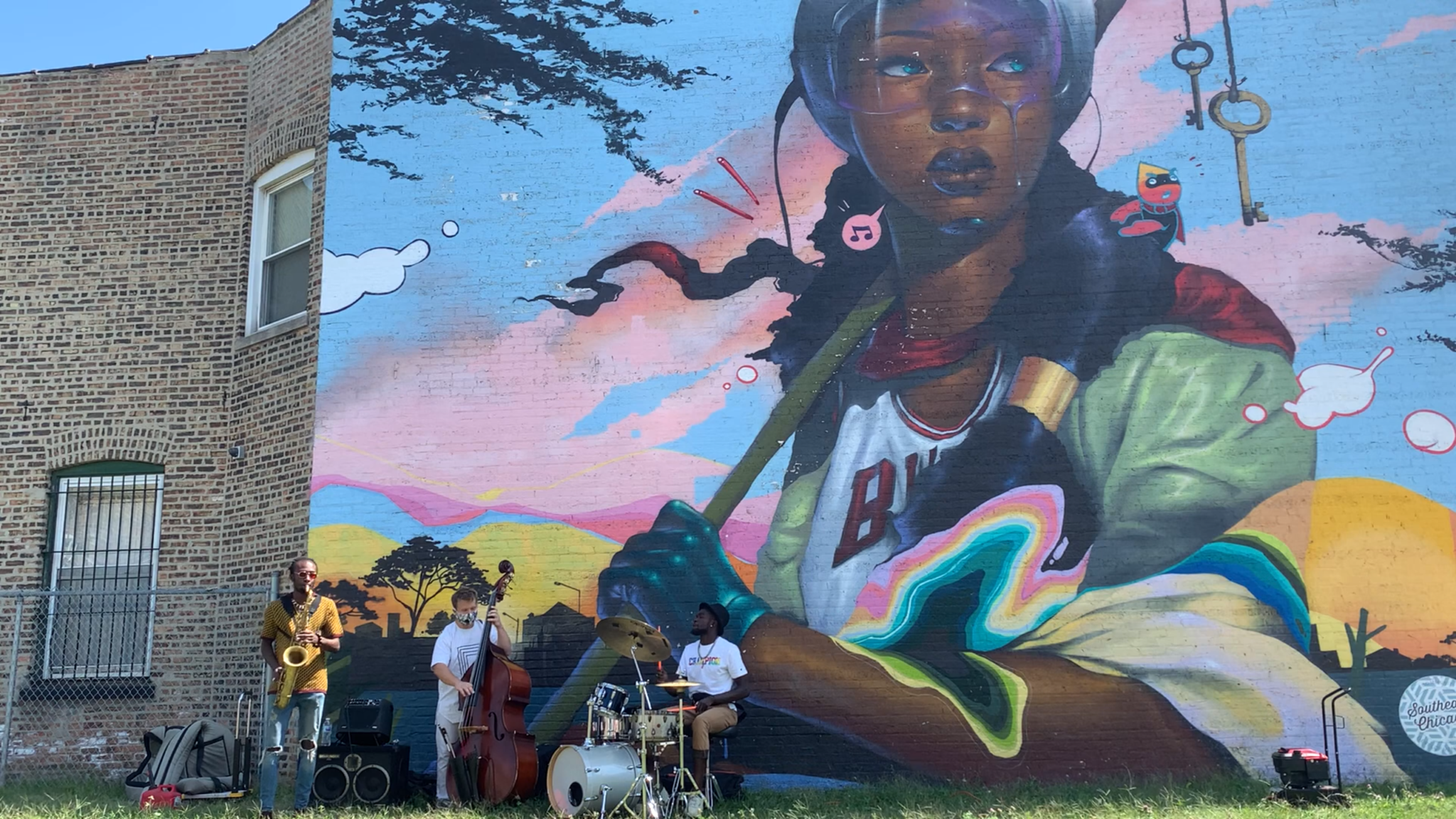
In years past, on a given day each summer, horns would wail and drums would pound from the backyards of residents of South Paxton Street who had donated their greenspace to the cause of live jazz.
Led by Chicago artists Fo Wilson and Norman Teague, with support from South Shore Works and individual community members, “Back Alley Jazz” honors the outdoor jazz jam sessions that traditionally took place throughout the South Side during the sixties and seventies. “The project creates a contemporary neighborhood happening that animates, builds on, and celebrates Chicago’s history and continuum of culture and art in communities,” said a written entry on the website of the Hyde Park Jazz Festival, Back Alley Jazz’s partner organization.
Thanks to the pandemic, Back Alley Jazz could not take place this year in its traditional format.
So in lieu of crowded gatherings in residents’ backyards, along one neighborhood block, small jazz combos set up across South Shore in private yards and public spaces like the steps of St. Philip Neri church, or the corner of 71st and Jeffery. Wilson said masks and social-distancing measures were both required.
“[People] were very cooperative around that restriction,” Wilson said. “Everyone wanted to enjoy great music, their neighbors, and not put anyone in danger.”
Despite the smaller scale, Back Alley Jazz still featured some of Chicago’s most prominent jazz musicians and groups, including saxophonist Isaiah Collier and his group The Chosen Few, The Marlene Rosenberg trio, and the Rajiv Halim quintet. The ensembles touched on myriad sounds and styles in their sets, with their music ranging from takes on old school jazz standards to more progressive sounds and styles.
Kate Dumbleton, executive and artistic director for the Hyde Park Jazz Festival, said that at its core, Back Alley Jazz is about justice. “It’s about the right to express culture in your neighborhood, and wherever you’d like to, and to ask for the resources to do that,” she said. (Ryan Rosenberger)
Back Alley Jazz, hydeparkjazzfestival.org/backalleyjazz
Best Hard-Won Grocery Store
Local Market
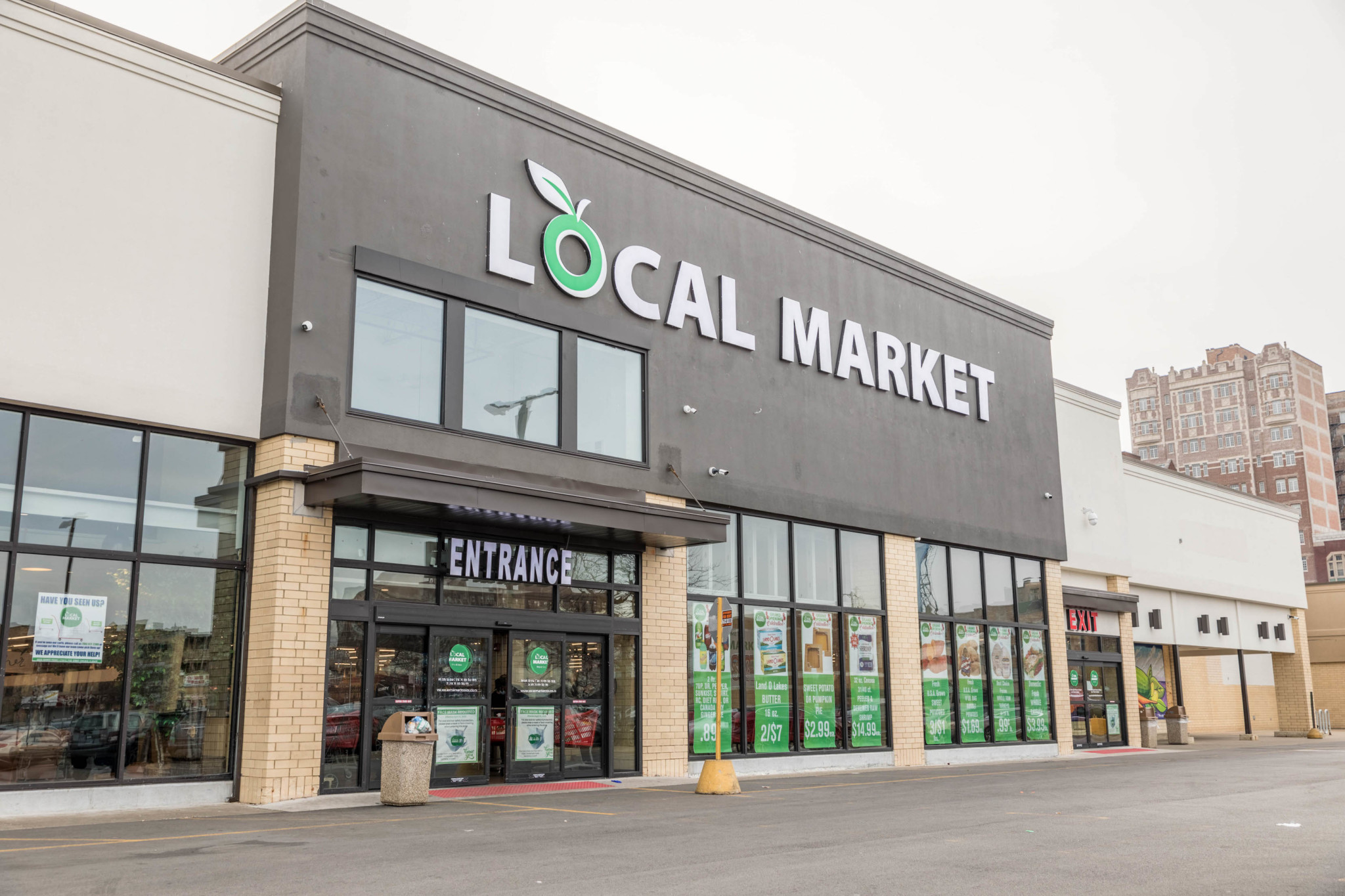
When Local Market opened in December 2019 in Jeffery Plaza, it was the culmination of years of organizing by South Shore block clubs and other residents. Finally, six years after the Dominick’s at that site had closed, the neighborhood again had the grocery store it wanted. Sure there’s a Save A Lot and a Jewel nearby, but “community members wanted a certain type of grocery store,” said Neighborhood Network Alliance steward Val Free. They wanted organic options; they wanted amenities, someplace “where they could sit down and eat and have a glass of wine and do all the things that they could do at a Mariano’s.” Despite the restrictions of COVID-19, for six months this year, South Shore had all that and more. And then came what Free called “the uprisings.”
In the early days of June, as the George Floyd protests spread across the city, the civil unrest and looting that hit downtown and swaths of the South and West Sides came to Jeffery Plaza. Local Market closed after several people broke in through the roof of the store. The community that had worked for years to get the market there in the first place mobilized. For two days, fifty or sixty people gathered to clear up debris and to show support for the market’s workers, some of whom were afraid to come to work. The message: “Not on our watch.”
It worked. “It didn’t stop them from looting other stores in that mall,” said Free, “but they definitely stopped at the Local Market.”
Since then, things have been calm. Business is good; all is stable. The Feeding South Shore program, which delivered free groceries from Local Market to 1,000 South Shore families over the summer, was recently rebooted for the winter months. Funded by an anonymous donor and the Northern Lights Direct marketing agency, and renamed “Feeding Chicago Families,” it aims to provide 3,200 bags of poultry, produce, and other items to families at schools in South Shore, Oakland, and Hyde Park, as well as La Rabida Children’s Hospital.
Over the summer, a mural was painted on the wall outside the store. “The community definitely came together to make sure there was a clear signal: this is not to be touched,” Free said. (Martha Bayne)
Local Market, 2101 E. 71st Street. Mon-Sat 7am-9pm; Sun 7am-8pm, (708) 617-2300. localmarketfoods.com. Anyone interested in donating to Feeding Chicago Families should email Amena Karim at amenakarim932@gmail.com.
Best Movement to End Chicago’s Largest Private Police Force
#CareNotCops
Best Abolitionist Dance Parties
The #Defund Protests
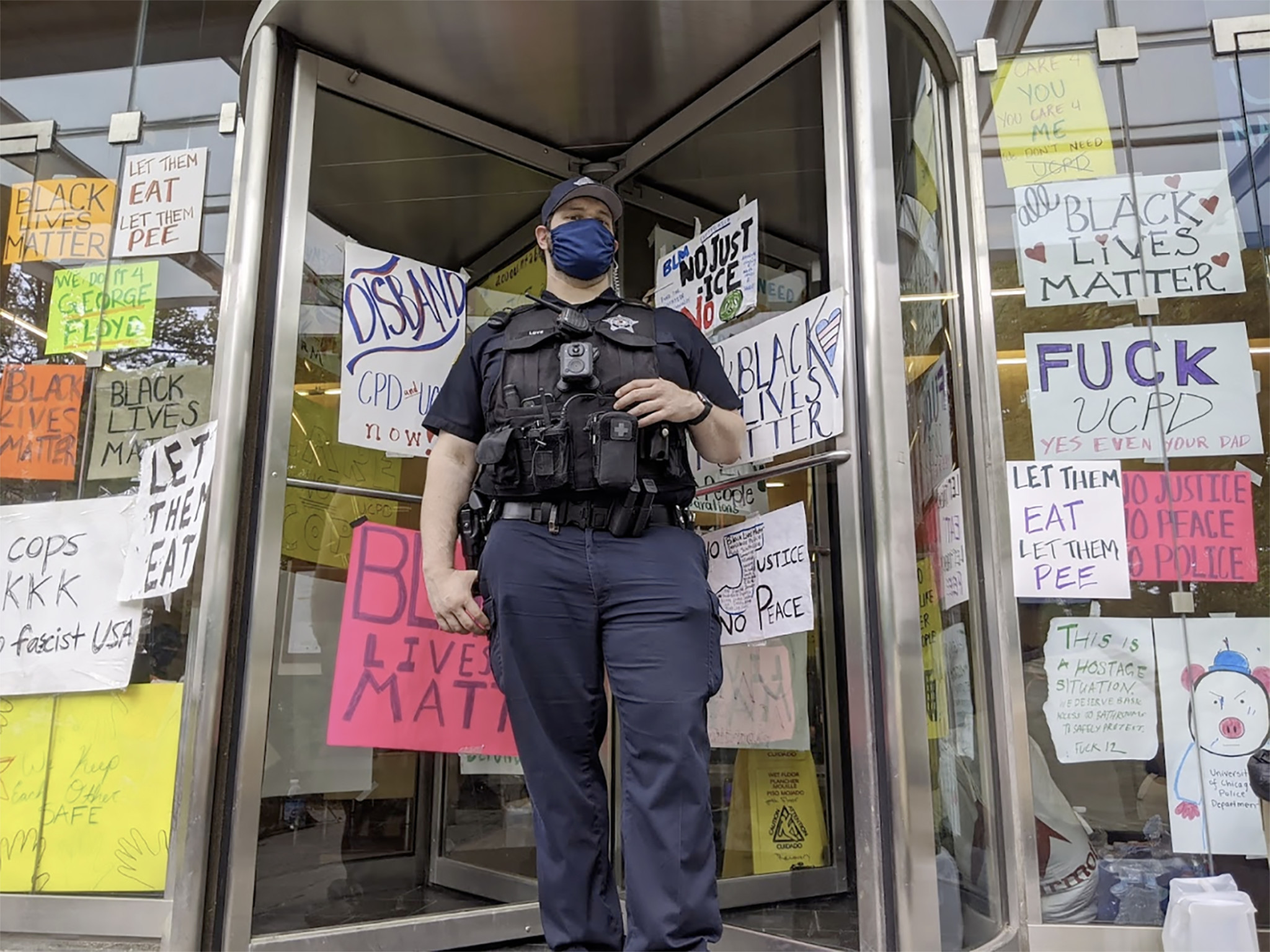
This summer’s uprisings centered abolition in Chicago’s political discourse in a way we haven’t seen for decades. They followed years of organizing for police accountability and against austerity, and months of pushing for an equitable COVID-19 response.
As thousands rallied into the streets to demand justice, there was a deep ambivalence—grief over the tragic deaths of George Floyd and Breonna Taylor, rage at the institutions producing systemic violence, power in being in solidarity with thousands of people after months of feeling disconnected, anger that cops won’t even wear a fucking mask, joy in seeing friends (serendipitously!) for the first time in months, resolve to struggle for real change, care from and for strangers, curiosity to listen and learn, and anxiety about the unknown dangers of mass protests.
Mayor Lori Lightfoot responded to the protests downtown on May 30 by raising bridges, instituting a curfew, and limiting access to public transportation and the Loop—cutting off Chicago. Riots and protests for abolition spread throughout the city as communities and organizers came together to advocate for demands both local and sweeping.
On June 12, the abolitionist University of Chicago student organizers of #CareNotCops joined community members in occupying the Woodlawn headquarters of UCPD, one of the largest private police forces in the world. Their sit-in lasted for over twenty hours and had four demands: “to disarm, disclose the budget of, defund by fifty percent, and ultimately abolish the UCPD.” Occupying protestors weren’t allowed to use the restrooms, and were denied access to the food, water, and medicine outside activists attempted to bring in. Within an hour over a hundred people came to offer tents, food, music, diapers, other supplies, and most of all, energy and solidarity. “That night, organizers turned a police headquarters that centers violence and harm into a true community space, with music, skill-sharing, and base building,” a #CareNotCops demonstrator said in a statement to the Weekly.
Partway through the evening, a dance party broke out. Students, alumni, community members, and a contingent of ten or so balaclava-clad black bloc activists blasted requests from the twenty or so #CareNotCops activists inside the station, sharing cheer and phone notes in between the bright collage of signs covering the glass facade (“UCPD serves stockholders,” “let them eat, let them pee,” “reparations NOW,” “Black Lives Matter,” and “everybody hates the police” among them). The collegiate zoomer song requests included Chloe X Halle’s “Do it,” Charli XCX’s “Vroom Vroom,” Megan Thee Stallion’s “Sex Talk,” and Nicki Minaj’s “Super Bass.” During a summer that saw no music festivals and no clubs, and most dancing groups relegated to Zoom calls, this collective joy—shared across a policed boundary—was indicative of the solidarity to come across abolitionist protests over the rest of the summer and fall.
#CareNotCops described their follow up occupation to the Weekly: “Building off of this action, students, alongside organizers from across the city, came together once again to occupy the space outside of UChicago Provost Ka Yee Lee’s home in August. The provost is the chief budgetary officer of the university, and protesters called for a public, transparent meeting with UChicago administrators. The administration thus far has refused to hold a public meeting and has not addressed any of the demands. This space was occupied for seven days, involving hundreds of students, alumni, organizers, and community members, and in this time organizers built community, held organizing trainings, and demonstrated power. Ultimately, after seven days of harassing protesters, UCPD and CPD officers tore down the community space that was created. Undeterred after leading the longest consecutive action against the UCPD in history, protesters chanted emphatically, ‘WE WILL BE BACK.’” (J. Michael Eugenio)
#CareNotCops. Twitter: @care_not_cops; Instagram: @carenotcops; Facebook: UChicago Care Not Cops.
Best Homegrown Humanitarian
Olivia Issa
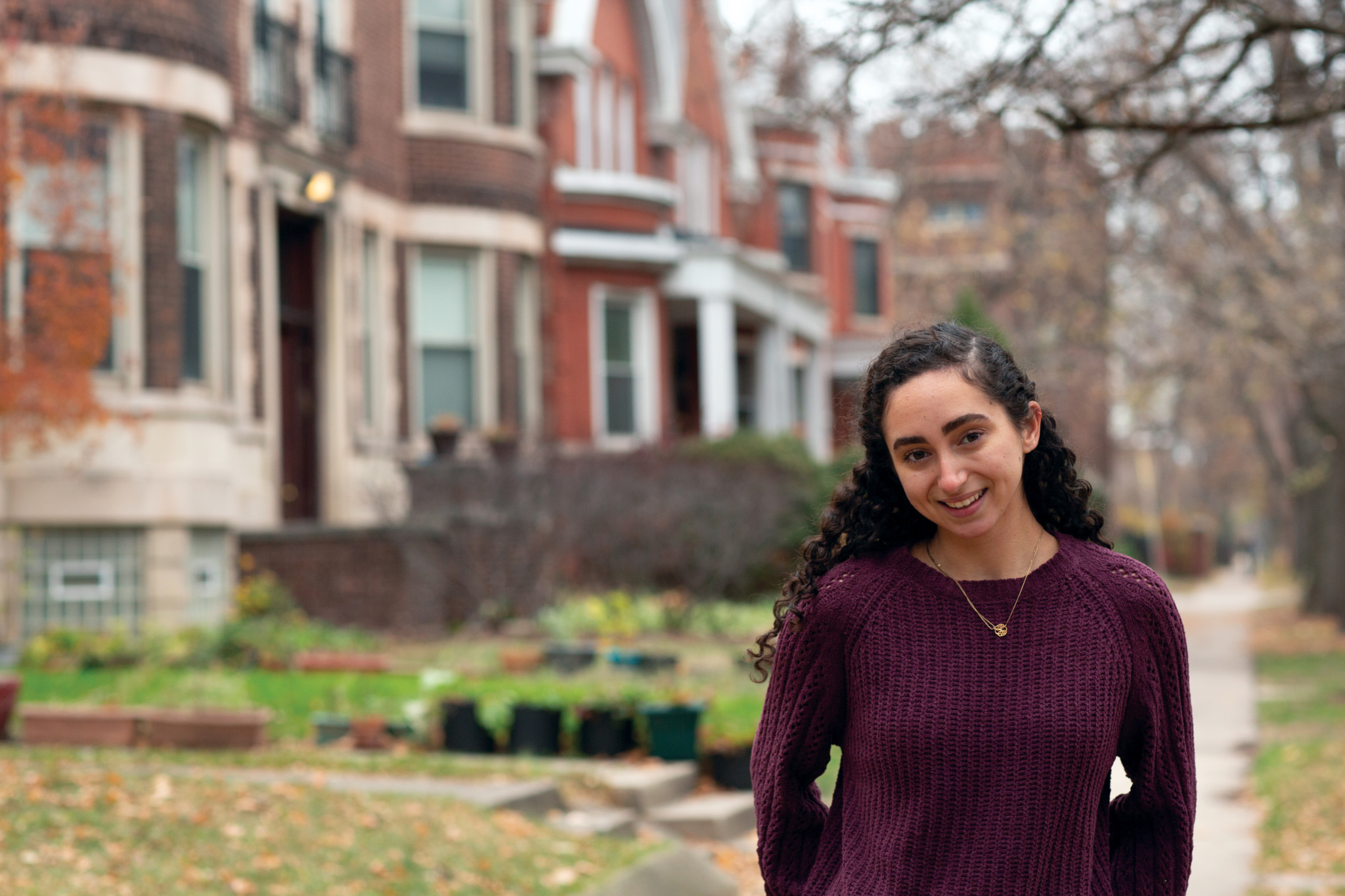
When the photograph of Alan Kurdi, the three-year-old Syrian boy who drowned in the Mediterranean Sea en route to Greece during the Syrian refugee crisis, washed across Olivia Issa’s phone in 2015, she was visiting family in Lebanon, sharing a bed with her two younger brothers, both fast asleep. “I was scrolling through Facebook, and I opened the picture, and I looked at the two of them next to me, and I said, ‘They used to be that small. And I used to hold them—and we were safe—but that could really be us.’” She had already noted the enormity of the refugee crisis; the number of displaced families all around her forced to flee their country to escape the rapidly-escalating war. At the time, a makeshift tent settlement ran down the side of the entire mountain where her great-grandmother’s house was located, covered in blue tarp, housing some among the 1.5 million Syrian refugees Lebanon has welcomed since the beginning of the Syrian Civil War in 2011. “Seeing how close that was to my family,” she recalls, “I realized: ‘Okay, this is not a far-off situation. This is a very human situation. Why am I not doing anything?’ ”
Back in Chicago and starting her sophomore year of high school, she connected with RefugeeOne, Chicago’s largest refugee resettlement group, which operates out of West Ridge. She and her mother began spending Sundays driving up to the Far North Side—where most refugee populations are resettled in Chicago—to provide one-on-one tutoring services to students, primarily from four Syrian and Iraqi families that arrived in the U.S. between 2015 and 2017. It wasn’t long before they were approached by an intrigued neighbor, Dorothy Pytel, eager to replicate the same grassroots model of refugee resettlement established on the North Side in their home community of Hyde Park. From a group of ten volunteers meeting in the basement of Augustana Church just days after the 2016 presidential election, the Hyde Park Refugee Project (since joined by co-directors Lisa Jenschike and Anna Zonderman) has now successfully sponsored the resettlement of two Syrian families into Hyde Park and Kenwood and grown to support forty-five resettled individuals across six families in total.
Looking back, Issa describes her role as a volunteer in the early days of 2017: finding apartments, setting up furniture, stocking the pantries with food and supplies, and then getting going with tutoring and conversation plans—all while a freshly-inaugurated President Trump issued his first Muslim ban, indefinitely suspending the entry of all Syrian refugees into the United States and temporarily prohibiting refugees from other countries as well. Issa soon found herself in a bespoke role, acting as mediator between the Refugee Awareness Club she had founded at the University of Chicago Lab High School, which sparked a ready supply of eager high school volunteers, and potential donors, fundraising, and outreach projects, redirecting both streams to the resources and needs of the Hyde Park Refugee Project.
Since leaving Hyde Park in 2018 to study political science at George Washington University, Issa has remained connected to the families she worked so closely with, whether exchanging letters and postcards, cheering on her former students—the oldest of whom are now seniors at Kenwood Academy—or running the HPRP’s summer camp last year. The summer camp includes field trips all over the city, scavenger hunts, dance classes and cooking experiments, musical guests, and conversation practice all dedicated to combating “summer slide” (when kids start losing English-language abilities during summer months due to lack of exposure) and nurturing community in her refugee and ESL immigrant campers, aged five to fifteen. While camp has moved online this year, Issa has continued to teach a thrice-weekly Zoom dance class, in which she combines fun music and upbeat exercises with interactive activities, a dance-themed “word of the week,” ample chances for social interaction, and intentional beginner’s mindfulness and deep breathing. “I try to always have a finger on the pulse of what they’re doing,” she said.
Back in DC, she is now connecting her experiences in community, nonprofit, and grassroots spaces to the advocacy and policy side, chairing a steering committee of the University Alliance on Refugees and At-Risk Migrants, a student-led group of graduate students, researchers, and policymakers from around the country with the goal of making higher education more accessible for those who have faced forced migration, as well as leading her university’s chapter of No Lost Generation and interning for U.S. Senator Tammy Duckworth.
“I don’t necessarily think that I will work too much in government spaces,” said Issa, “but being there and starting to understand what happens when you call your elected officials—I was on the receiving end of those calls—it felt like I was really connecting the work we do in community organizing when we say, ‘Call your representatives.’ I got to see who called about what and really connect that to the policy that was in the works. If a thousand people from Illinois call in to support one issue or oppose it, that’s a really big deal. It’s enough for the Senator to say: “Okay, this is what the people of Illinois need from me, and need me to stand for.” (Malvika Jolly)
Find more information about and donate to the Hyde Park Refugee Project’s 2020 Winter Appeal at charity.gofundme.com/o/en/campaign/hydepark-refugee-project-2020-winter-appeal.
Best Socially-Distanced Revels
Hyde Park Bonfire Club
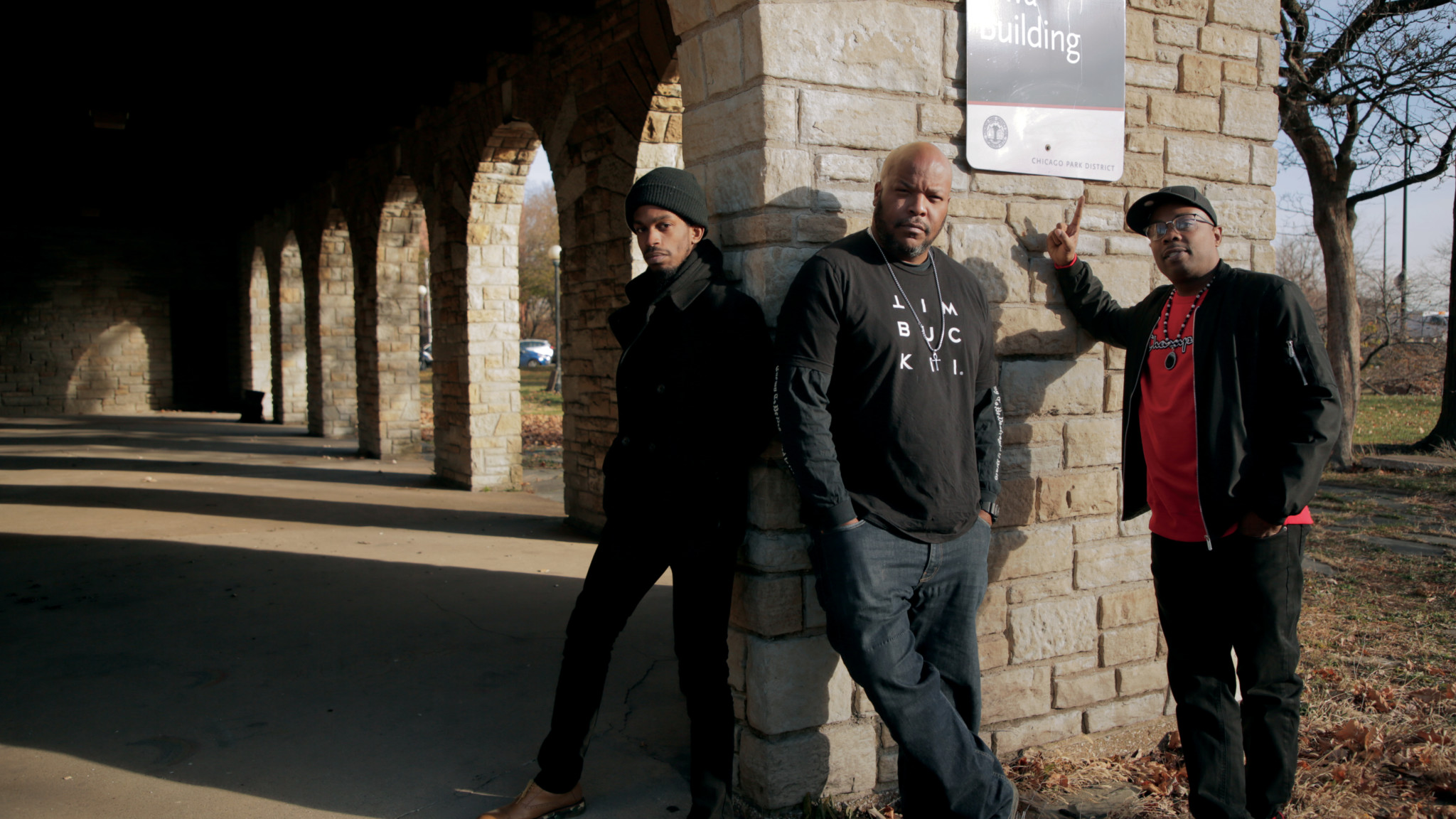
All his adult life, Gerald Cook has had a grill and a cooler ready in the trunk of his car. By day, data programmer for the United Credit Union and, by night, bartender at the Cove Lounge, Cook has found his calling as de facto founder of the Hyde Park Bonfire Club—an eclectic group of friends that, pre-COVID, would meet up monthly at the Promontory Point bonfire pits in the summer months to eat, drink, listen to good music, and practice the time-honored art of the chill. This summer, given Mayor Lori Lightfoot’s closure of the lakefront and adjacent parkland, he sat down to devise a new plan for an updated, socially responsible, and socially distanced alternative.
The Hyde Park Bonfire Club 2.0 proved a huge success. Instead of the lakefront, it met at the Iowa Building, an open-air limestone pavilion on the eastern end of Jackson Park. Usually dated to the 1893 World’s Columbian Exposition from which it still informally carries its name, the Iowa Building actually predates the fair according to an 1895 Report from the Iowa Columbian Commission—attributed only to “an architect employed some years before the Fair” who wished to design “a shelter in the time of storm” specifically with “visitors and picnic parties” in mind. “It was just perfect for what we were trying to do,” said Cook. “We couldn’t ask for more.”
The atrium is outdoors, with plenty of air flow, and occupies a plot of Jackson Park that’s approximately 217,800 square feet. To this, Cook brought sanitation stations with gloves, masks, and sanitizer, and instructions to spread out throughout the pavilion and park. He also stipulated policies of “sit with who you come with,” no close dancing, and that only volunteers who were gloved and masked could serve food—“so people couldn’t necessarily just walk up and start grabbing things.” He even drew lines on the limestone floor in chalk to help visualize six feet’s distance.
“We kind of regulated ourselves,” he explained, keeping in line with the regulations restaurants permitting outdoor dining were expected to comply with. “As we went along we ironed out the kinks and were able to guide our guests on how we wanted to operate, and everyone was in line with that.”
From there, the Bonfire Club, sans bonfire, took on a life of its own. “It started off simply as a barbeque, grill, and a cooler type deal,” Cook explained. “Then one of our friends, Hamid Harris, a Hyde Parker and a local chef, donated his talents to our events. Suddenly we realized that we were all a bunch of foodies! It was really great to have him out there cooking everything with a level of expertise that you don’t usually see at a potluck.” At first guests were mostly regulars from the Cove, then word spread around the corner to the Falcon, and soon they had “everyone from retired professors and university students to people who work in Hyde Park but don’t live here and people who live in Hyde Park to people who don’t.” Said Harris, who grew up all over the city but today calls Hyde Park home, “In the South Side, the community we’re in—artists, all sorts of musicians, bartenders, mixologists, chefs, painters—we have a pretty close-knit community, even though it’s a widespread net.”
Local talent brought the music: DJ Brian Sayles, DJ Ralph ‘Da Hoov’ Liggins, and DJ Puncho—aka Don Peko, one half of the duo that gave Juke music, a subset of Chicago House that was the constant soundtrack to the late nineties, its name back in ‘97. None of them were working live events because of the lockdown, and so they showed up to donate their time and talent. When they weren’t playing House, they played old school R&B, a lot of funk, a bit of reggae, some Héctor Lavoe, some salsa. And the food? Harris, who has cooked and worked at restaurants all over the country, explained that it was nothing like anything he’d done before: “The thing about these events is that nothing I made was really planned. It was all about what people brought up there. [Once or twice] I brought a shark fillet and some scallops; after that, people brought in about fifty pounds of food each time. People are carrying it all in, I have about fifty bags of groceries, and I don’t really have time to plan. I’m just Iron Chef-ing it. And I hardly remember anything I did. I’m standing in the smoke and delirious all day.”
Reflecting on the past year, Cook said, “I think a lot of people really needed this, after being quarantined since March. So what we did is we took some of the love and the spirit from the Cove, and brought it out to a different space.” When asked to describe the eclectic community that turned out, Harris said, “It had nothing to do with anything else other than the people under that roof. For me that was the most liberating thing of all. Off-the-grid and by-the-rules, so I liked that.” (Malvika Jolly)
Hyde Park Bonfire Club. facebook.com/groups/721280121721578

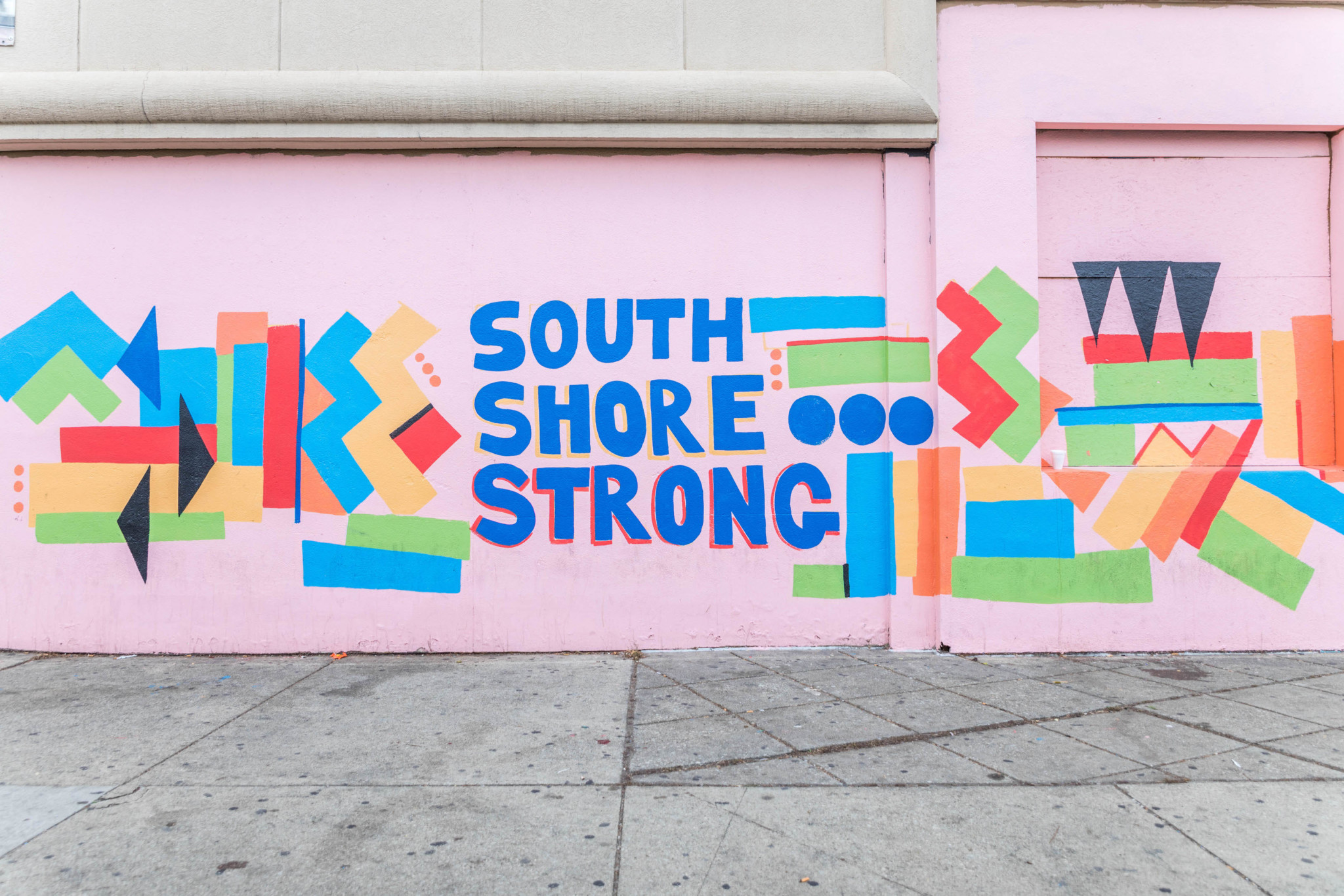
Awesome, VERY proud of you bro.
I wish I could get them to do a story on ma and the reentry work were doing at Chicago Cook Workforce Partnership.
CONGRATS
Martha, thank you for highlighting The Neighborhood Network Alliance.
You’re welcome!
Having read this I believed it was really enlightening.
I appreciate you spending some time and effort to put this content together.
I once again find myself spending way too much time both reading and leaving
comments. But so what, it was still worth it!